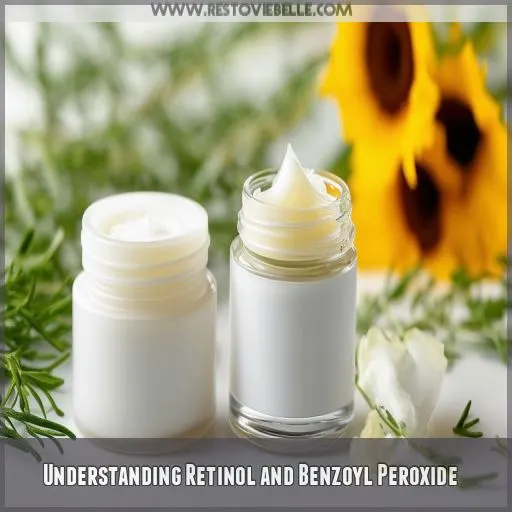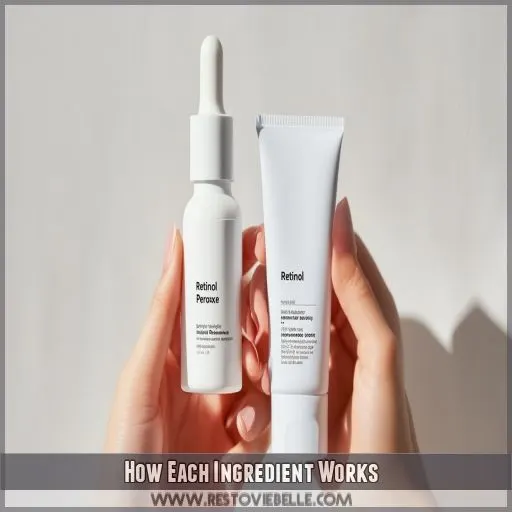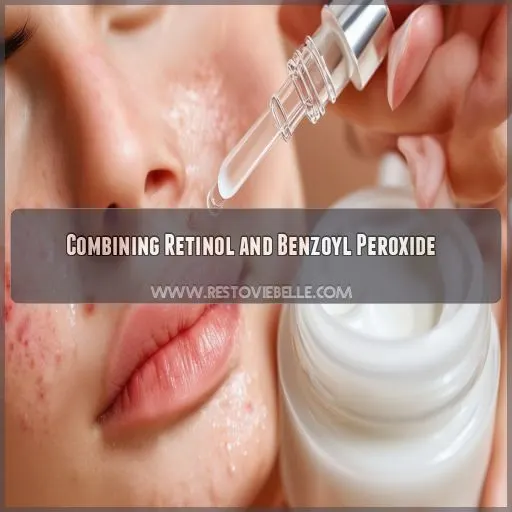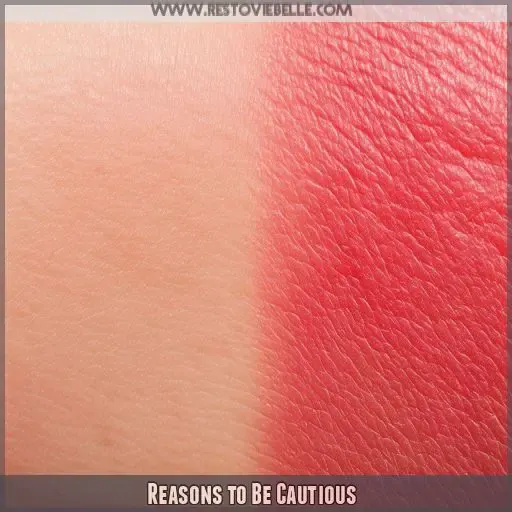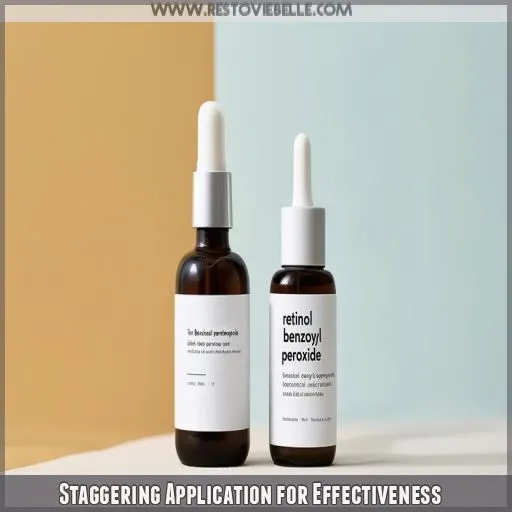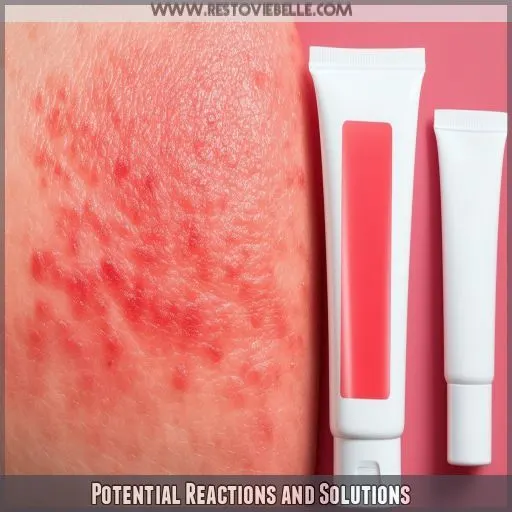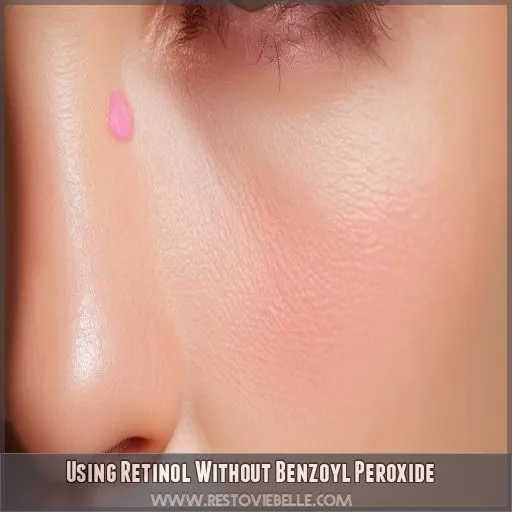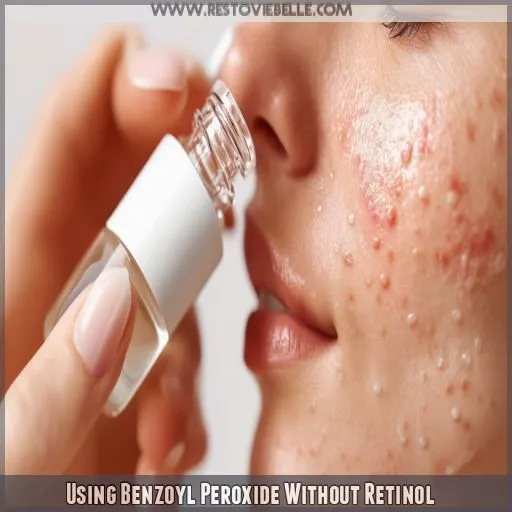This site is supported by our readers. We may earn a commission, at no cost to you, if you purchase through links.

You may have heard that these two ingredients can be a powerful duo for fighting acne and reducing the appearance of scars.
However, you might also be wondering if it’s safe to use them together.
In this article, we’ll explore the benefits and potential drawbacks of combining retinol and benzoyl peroxide, and provide expert advice on how to use them effectively.
Table Of Contents
- Key Takeaways
- How to Use Retinol With Benzoyl Peroxide Together?
- Understanding Retinol and Benzoyl Peroxide
- How Each Ingredient Works
- Combining Retinol and Benzoyl Peroxide
- Reasons to Be Cautious
- Staggering Application for Effectiveness
- Potential Reactions and Solutions
- Alternatives to Consider
- Using Retinol Without Benzoyl Peroxide
- Using Benzoyl Peroxide Without Retinol
- Frequently Asked Questions (FAQs)
- Can you mix retinol and benzoyl peroxide?
- Are retinoids better than benzoyl peroxide?
- Should I use retinol & benzoyl peroxide at night?
- Can you mix tretinoin and benzoyl peroxide?
- Can I use retinol while using benzoyl peroxide?
- Can I use retinol and acne treatment at the same time?
- What is the best combination with retinol for acne?
- Can you use benzoyl peroxide in morning and tretinoin at night?
- Can benzoyl peroxide and retinol be used at the same time?
- What are the benefits of using benzoyl peroxide and retinol together?
- Are there any side effects to using benzoyl peroxide and retinol simultaneously?
- How long should I wait between applying benzoyl peroxide and retinol?
- What are some alternatives to benzoyl peroxide and retinol?
- Conclusion
Key Takeaways
- Timing is everything! Use benzoyl peroxide in the morning and retinol at night – it’s like giving each ingredient its own spotlight on the skincare stage.
- Ease into it, tiger. Start with low concentrations and gradually build up your skin’s tolerance. Rome wasn’t built in a day, and neither is a flawless complexion.
- Keep your eYes peeled for any signs of irritation. If your skin starts throwing a tantrum, it’s time to hit pause and call in the pros (aka your dermatologist).
- Don’t be afraid to mix things up. If this power couple is too much for your skin, there are plenty of fish in the sea – try alternatives like salicylic acid or vitamin C serums.
How to Use Retinol With Benzoyl Peroxide Together?
If you’re wondering how to use retinol with benzoyl peroxide together, proceed with caution.
These powerful ingredients can irritate your skin when combined.
It’s best to use them separately: apply benzoyl peroxide in the morning and retinol at night.
This staggered approach allows each ingredient to work effectively without interfering with the other.
Always start with low concentrations and gradually increase usage.
If you have sensitive skin, consider using a benzoyl peroxide wash instead of leave-on products.
If you experience any redness, dryness, or peeling, stop use and consult a dermatologist.
There’s more to learn about maximizing these ingredients’ benefits safely.
Understanding Retinol and Benzoyl Peroxide
Retinol and benzoyl peroxide are two popular ingredients in skincare, each with its unique benefits and uses. Retinol, a form of vitamin A, is a chemical exfoliant that dissolves dead skin cells and stimulates collagen and elastin production, resulting in a more youthful appearance. It’s available in over-the-counter and prescription strengths.
On the other hand, benzoyl peroxide is an over-the-counter topical medication known for its antibacterial properties. It’s often used to treat mild to moderate acne by killing acne-causing bacteria, reducing inflammation, and controlling excess oil on the skin.
How Each Ingredient Works
Now that you understand the basics of retinol and benzoyl peroxide, let’s break down how each of these ingredients works and what they can do for your skin.
Benzoyl peroxide is a powerful acne-fighting ingredient. It kills the bacteria that cause acne and reduces inflammation. This ingredient also helps control excess oil production and exfoliates the skin, unclogging pores.
Retinol, a member of the retinoid family, is a versatile skincare superstar. It stimulates collagen production, promoting firmer, younger-looking skin. Retinol also speeds up cell turnover, helping to clear acne and reduce fine lines and wrinkles.
Retinol is often used to reduce pigmentation, treat acne, and improve the appearance of fine lines and wrinkles. Benzoyl peroxide, on the other hand, is typically used to treat mild to moderate acne. It can be found in various forms, including cleansers, lotions, and spot treatments.
Both ingredients offer significant benefits, but it’s important to remember that they can also be potent, so caution is advised when incorporating them into your skincare routine.
Combining Retinol and Benzoyl Peroxide
Combining retinol and benzoyl peroxide can be a tricky business. Technically, you can use these two ingredients together, and some products even contain both. However, it’s a bit like trying to mix oil and water – they don’t always play nicely.
Retinol, a form of vitamin A, is an anti-aging powerhouse, reducing fine lines and wrinkles. It’s also an effective acne fighter. Benzoyl peroxide, on the other hand, is a go-to treatment for mild to moderate acne due to its bacteria-busting abilities.
But here’s the catch: using these ingredients simultaneously can irritate your skin, causing dryness, redness, and sensitivity. It’s like your skin is crying out, "Hey, too much of a good thing!"
Reasons to Be Cautious
When using retinol and benzoyl peroxide together, it’s important to be cautious as combining these ingredients can irritate your skin, leading to dryness, redness, and discomfort. To avoid this, experts recommend using benzoyl peroxide in the morning and retinol at night, but if you have sensitive skin, it’s best to consult a dermatologist before giving it a go.
Skin Irritation Hazards
While benzoyl peroxide and retinol can be used together, combining them may irritate your skin. This irritation could lead to dryness, redness, peeling, and discomfort. To avoid this, experts recommend using benzoyl peroxide in the morning and retinol at night. If you have sensitive skin, consult a dermatologist before using these ingredients together.
Morning vs Night Routine
To maximize the benefits of both ingredients, experts recommend staggering your application throughout the day. Use benzoyl peroxide in the morning and retinol at night. This schedule allows each ingredient to work independently and avoids potential interference.
Consult Dermatologist First
Consulting a dermatologist before combining retinol and benzoyl peroxide is a wise move.
They can offer personalized advice on product choices and application methods, making sure you achieve your skincare goals without compromising your skin’s health.
Dermatologists can provide guidance on the best ingredients and routines for your specific skin concerns, helping you avoid the potential pitfalls of mixing powerful ingredients like retinol and benzoyl peroxide.
Staggering Application for Effectiveness
If you’re keen to use both ingredients, staggering your application is a smart move. This approach lets each powerhouse shine without getting in each other’s way. Think of it like giving them their moment in the spotlight.
So, when’s the best time to use benzoyl peroxide and retinol? Dermatologists recommend a simple schedule: benzoyl peroxide in the morning, retinol at night. This timing gives your skin a break from potential irritation and helps each ingredient do its thing effectively.
For benzoyl peroxide, morning application makes sense because it’s a deep-cleaning agent that helps fight acne-causing bacteria. You can find it in cleansers, lotions, and spot treatments designed for daytime use.
As for retinol, nighttime is its prime time. This is when your skin is in repair mode, and retinol can work its magic stimulating collagen production and cellular turnover. Opt for a time-released formula to make sure gentle, consistent action happens while you sleep.
Potential Reactions and Solutions
Benzoyl peroxide and retinol are a popular combo, but they can be a bit of a handful for your skin. You might see some dryness, irritation, and sensitivity. Redness, peeling, flaking, and discomfort are all on the menu.
If you’re up for the challenge, play it safe. Try benzoyl peroxide in the morning and retinol at night. This gives each ingredient some space to work its magic without getting in each other’s way.
Keep a close eye on how your skin reacts. If things start to look red and angry, it’s time to hit the pause button and call in the pros. A dermatologist can help you figure out the best plan for your skin. Remember, sometimes less is more when it comes to skincare.
Alternatives to Consider
If you want to skip retinol, you can try other vitamin A derivatives like retinoids, but be aware that these alternatives may still cause skin irritation. Instead of benzoyl peroxide, consider using salicylic acid or azelaic acid to treat acne.
Vitamin A Alternatives
If you’re seeking alternatives to retinol, there are other vitamin A derivatives, known as retinoids, that offer similar benefits. However, these alternatives also carry a risk of irritation. Topical treatments containing vitamin C, resveratrol, niacinamide, or plant stem cells can be used alongside retinol to enhance its effects and reduce side effects.
Acne-Fighting Options
If you’re looking for alternatives to benzoyl peroxide and retinol, here are some acne-fighting options to try in your skincare routine:
- Salicylic Acid: This ingredient exfoliates inside pores, clearing debris and preventing breakouts. It’s a great option for treating acne without the potential irritation of benzoyl peroxide.
- Azelaic Acid: Azelaic acid is another effective acne-fighting alternative. It helps to treat acne by reducing inflammation and killing bacteria.
- Sulfur-Based Products: Sulfur can be an effective ingredient in managing bacterial acne. It helps to reduce inflammation and treat breakouts.
Sensitive Skin Solutions
If you have sensitive skin, it’s important to be cautious when introducing new products into your skincare routine. Combining retinol and benzoyl peroxide can be especially tricky due to their potential for causing irritation and dryness.
To minimize irritation risks, opt for gentle products specifically formulated for sensitive skin. Consult a dermatologist for expert advice on the best approach for your unique skin concerns.
When starting a retinol routine, it’s key to introduce it gradually and monitor your skin’s reaction. This is especially important if you have sensitive skin, as retinol can be potent and cause dryness or discomfort.
Hyaluronic acid and growth factors are great ingredients to pair with retinol. They help minimize irritation and enhance its anti-aging benefits.
Using Retinol Without Benzoyl Peroxide
If you’re thinking about ditching benzoyl peroxide in your skincare routine, you can still get the benefits of retinol. As a vitamin A derivative, retinol helps with chemical exfoliation, removing dead skin cells and revealing healthier skin. It boosts collagen and elastin production, making your skin look younger.
When you start using retinol, be careful. Test it on a small patch of skin for a few days to see if you have any problems. Always apply retinol at night to avoid making your skin sensitive to the sun, and gradually add it to your routine, starting with lower concentrations. Consistency is key when it comes to seeing the best results from your retinol routine. Be patient and give your skin time to adjust to this powerful ingredient.
Using Benzoyl Peroxide Without Retinol
- Benzoyl peroxide is a powerful acne-fighting ingredient that can be used effectively on its own.
- It’s an over-the-counter topical medication with antibacterial properties, making it ideal for tackling mild to moderate acne.
- The key to successful benzoyl peroxide use is consistency. Regular application helps control acne-causing bacteria and excess oil production.
- Benzoyl peroxide is available in various forms, including cleansers, lotions, and spot treatments. Opt for lightweight, non-comedogenic products to avoid clogging your pores.
- While benzoyl peroxide is effective, it can also be drying. Be sure to introduce it gradually and observe how your skin reacts. If dryness occurs, adjust your routine by reducing frequency or combining it with a hydrating moisturizer.
Frequently Asked Questions (FAQs)
Can you mix retinol and benzoyl peroxide?
Yes, you can mix benzoyl peroxide and retinol, but it’s not recommended. The two ingredients can cancel each other out and cause skin irritation. Experts suggest using them at different times of the day.
Are retinoids better than benzoyl peroxide?
It depends on what you’re trying to treat. Both retinoids and benzoyl peroxide are effective acne treatments, but retinoids are more powerful and better suited to severe acne. Benzoyl peroxide is great for killing acne-causing bacteria and reducing oil production.
Should I use retinol & benzoyl peroxide at night?
Yes, it’s generally recommended to use benzoyl peroxide in the morning and retinol at night. This is because retinol increases skin sensitivity to sunlight.
Can you mix tretinoin and benzoyl peroxide?
Yes, you can mix tretinoin and benzoyl peroxide, but it’s not an over-the-counter medication, so use it only under medical supervision. Studies show no loss of tretinoin strength when mixed with benzoyl peroxide.
Can I use retinol while using benzoyl peroxide?
Yes, you can use both retinol and benzoyl peroxide, but not at the same time. The two ingredients may react and cancel each other out. Instead, stagger your application, using benzoyl peroxide in the morning and retinol at night.
Can I use retinol and acne treatment at the same time?
Yes, you can use retinol as an acne treatment. It can reduce acne marks and prevent pimples by removing dirt, dead skin cells, and oil from pores. However, retinol can cause an initial acne flare-up, so be cautious and patient when introducing it into your skincare routine.
What is the best combination with retinol for acne?
Retinol is often combined with other ingredients to treat acne. One of the most popular combinations is retinol with benzoyl peroxide, an antimicrobial agent. Other ingredients include hyaluronic acid, niacinamide, salicylic acid, and tea tree oil.
Can you use benzoyl peroxide in morning and tretinoin at night?
Yes, you can use benzoyl peroxide in the morning and tretinoin at night. However, be sure to moisturise and protect your skin from the sun during the day. If your skin is irritated, stop treatment and consult a dermatologist.
Can benzoyl peroxide and retinol be used at the same time?
Yes, but it’s not recommended. Benzoyl peroxide is an oxidizing agent, while retinol is an antioxidant. Using them together may cause a reaction, cancelling each other out. You could use one in the morning and one at night.
What are the benefits of using benzoyl peroxide and retinol together?
You’ll tackle acne and aging simultaneously. Benzoyl peroxide kills bacteria and reduces inflammation, while retinol boosts cell turnover and collagen production. Together, they’ll clear your skin and smooth fine lines, giving you a healthier, younger-looking complexion.
Are there any side effects to using benzoyl peroxide and retinol simultaneously?
You may experience dryness, redness, and irritation when using benzoyl peroxide and retinol together. Your skin might become more sensitive to sunlight, increasing the risk of sunburn. It’s best to consult a dermatologist before combining these potent ingredients.
How long should I wait between applying benzoyl peroxide and retinol?
Time is of the essence when juggling these skincare powerhouses. Wait at least 30 minutes between applying benzoyl peroxide and retinol. You’ll want to use benzoyl peroxide in the morning and retinol at night for best results.
What are some alternatives to benzoyl peroxide and retinol?
You’ve got options! Try salicylic acid or azelaic acid for acne instead of benzoyl peroxide. For anti-aging, look into vitamin C or peptides as retinol alternatives. Niacinamide’s a versatile choice that can tackle both concerns effectively.
Conclusion
Combining retinol and benzoyl peroxide might seem tricky, but it’s totally doable with a little planning.
Learning how to use retinol with benzoyl peroxide together can really boost their benefits for acne-prone skin.
Start by introducing each product separately, then gradually combine them in your routine.
Always consult a dermatologist before mixing potent ingredients.
Be patient, listen to your skin, and adjust your routine as needed to achieve the best results.

